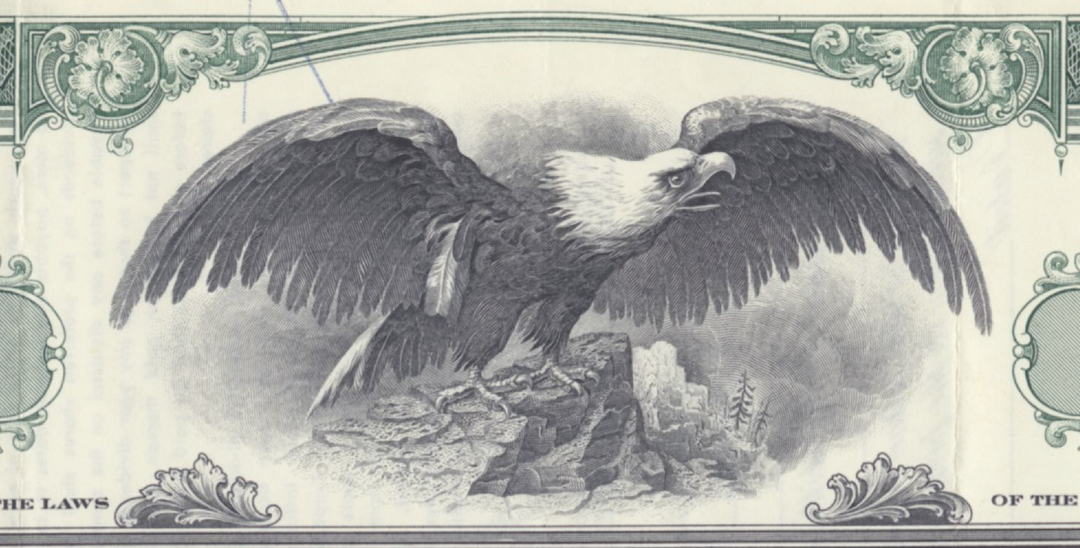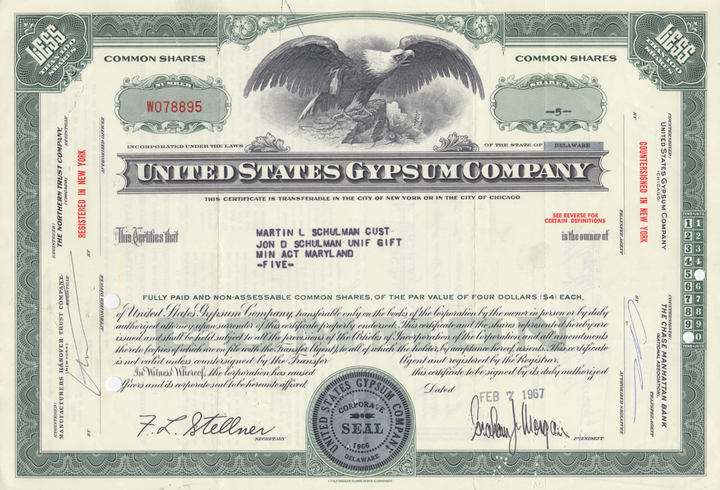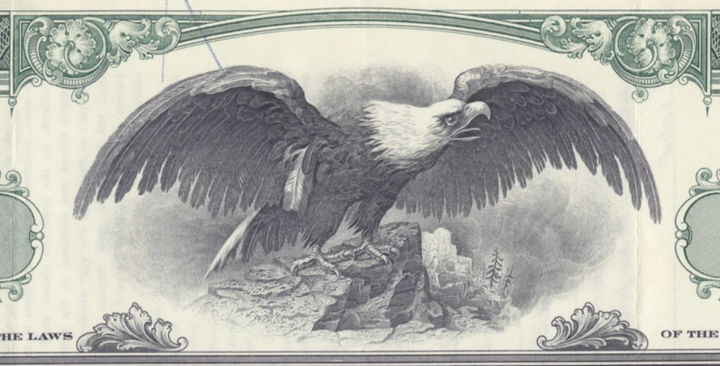United States Gypsum Company
- Guaranteed authentic document
- Orders over $75 ship FREE to U. S. addresses
Product Details
CompanyUnited States Gypsum Company
Certificate Type
Common Stock
Date Issued
1950's and 1960's
Canceled
Yes
Printer
Columbian Bank Note Company
Signatures
Machine printed
Approximate Size
12" (w) by 8" (h)
Images
Representative of the piece you will receive
Guaranteed Authentic
Yes
Additional Details
NA
Historical Context
In the 1890s, gypsum manufacturers perfected a method of strengthening plaster by adding a retarder, which controlled the setting time, thus creating a viable competitor to traditional lime plaster. Because gypsum was plentiful, and available at a relatively low price, and because the manufacturing process was so simple, new firms flooded and fragmented the market, placing constant downward pressure on prices.
On December 27, 1901, 30 gypsum and plaster companies merged to form the United States Gypsum Company, resulting in the creation of the first nationwide gypsum company in the United States. The new company combined the operations of 37 mining and calcining plants producing agricultural and construction plaster.
In 1909, USG purchased the Sackett Plaster Board Company, inventor of Sackett Board, which was a panel made of multiple layers of plaster and paper. By 1917, a new manufacturing process produced boards with a single layer of plaster and paper that could be joined flush along a wall with a relatively smooth surface. Originally called Adamant Panel Board, the product became known as SHEETROCK.
By the 1930s, the company's policy of diffusion of manufacturing facilities, vertical integration and product diversification allowed it to operate profitably every year during the Great Depression. The 1933 Chicago World’s Fair featured buildings made almost entirely out of SHEETROCK panels, which led to the brand's first major advertising campaign. Following the end of World War II, the residential building market boomed with the returning GIs and the emerging tract housing projects such as Levittown.
The 1950s and 1960s saw expansion into Mexico and other international markets.
Recession and its effect on the bottom line dominated the 1980s and led to a restructuring of the company. On January 1, 1985, USG Corporation was formed as a holding company — a reverse merger in which United States Gypsum Company became one of just nine operating subsidiaries.
In the mid- to late-1990s, the company invested in a significant expansion of its manufacturing network, adding new high-speed wallboard manufacturing operations in Rainier, OR, Bridgeport, AL, and Aliquippa, PA. Other existing operations were substantially rebuilt or modernized, including the wallboard manufacturing plant in East Chicago, IN.
In 2001, the company entered Chapter 11 bankruptcy proceedings to resolve legacy asbestos lawsuits. Asbestos was a minor ingredient in some specialty products that the company had stopped selling almost 40 years earlier, in the 1970s. The company's operations remained healthy and profitable while it was in chapter 11. When the bankruptcy was completed in 2006, all creditors were repaid in full and USG shareholders retained equity in the company. In a Wall Street Journal article dated February 15, 2006, Warren Buffett said, "It's the most successful managerial performance in bankruptcy that I've ever seen." A $3.95 billion trust was created to handle all existing and potential future asbestos lawsuits, thus permanently resolving the asbestos litigation issue.
Related Collections
Additional Information
Certificates carry no value on any of today's financial indexes and no transfer of ownership is implied. All items offered are collectible in nature only. So, you can frame them, but you can't cash them in!
All of our pieces are original - we do not sell reproductions. If you ever find out that one of our pieces is not authentic, you may return it for a full refund of the purchase price and any associated shipping charges.









